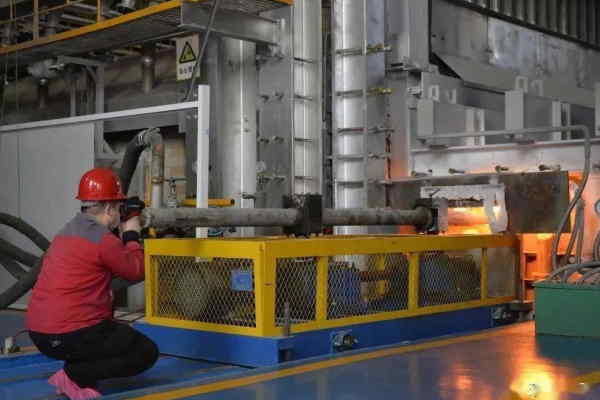I mattoni refrattari sono un tipo di materiale ceramico ad alta temperatura utilizzato per costruire e rivestire forni industriali, forni, e altre apparecchiature ad alta temperatura. Questi mattoni sono noti per la loro capacità di resistere a temperature estremamente elevate e ambienti chimici duri, rendendoli ideali per l'uso in contesti industriali.
Per gruppo refrattario discuterà i vantaggi di mattoni refrattari per forni e fornire alcune considerazioni per la loro installazione.


Vantaggi dei mattoni refrattari
Resistenza ad alta temperatura
I mattoni refrattari sono progettati per resistere a temperature estremamente elevate, che li rende ideali per l'uso in forni e forni. Questi mattoni sono in grado di mantenere la loro integrità strutturale anche a temperature superiori a 3000 ° F, rendendoli perfetti per l'uso in applicazioni ad alta temperatura.
Resistenza chimica
Un altro vantaggio dei mattoni refrattari è la loro capacità di resistere Attacco chimico. Questi mattoni sono in grado di resistere a ambienti chimici difficili senza abbattere, Il che è cruciale per le applicazioni industriali che comportano l'uso di sostanze chimiche.
Bassa conduttività termica
I mattoni refrattari hanno una bassa conduttività termica, il che significa che sono in grado di isolare contro il calore. Questo è importante nei forni e nei forni perché aiuta a mantenere la temperatura desiderata riducendo al contempo il consumo di energia.
Alta resistenza
I mattoni refrattari sono noti per la loro alta forza e durata. Sono in grado di resistere alle esigenze fisiche degli ambienti industriali e possono durare per molti anni senza dover essere sostituiti.
Versatilità
I mattoni refrattari sono disponibili in una varietà di forme e dimensioni, Il che li rende altamente versatili. Possono essere utilizzati per costruire e rivestire una vasta gamma di apparecchiature ad alta temperatura, Dai forni e forni a inceneritori e caldaie.


Considerazioni sull'installazione
Scegliere il giusto tipo di mattone
Quando si tratta di installare mattoni refrattari, È importante scegliere il giusto tipo di mattone per il lavoro. Diversi tipi di mattoni refrattari hanno proprietà diverse e sono progettati per l'uso in diverse applicazioni. Per esempio, mattoni ad alto contenuto di allumina sono ideali per l'uso in ambienti ad alta temperatura, Mentre i mattoni Fireclay sono più adatti per applicazioni a basso temperatura.
Curanti correttamente i mattoni
Dopo che i mattoni sono stati installati, È importante curarli correttamente prima di metterli in uso. La polimerizzazione implica riscaldare lentamente i mattoni alla temperatura desiderata, che aiuta a rafforzarli e prevenire il cracking.
Sigillare correttamente le articolazioni
Per garantire che il forno o il forno sia adeguatamente isolato, È importante sigillare le articolazioni tra i mattoni refrattari. Questo aiuta a impedire la fuga del calore e può anche aiutare a prevenire l'accumulo di gas dannosi.
Manutenzione regolare
Come qualsiasi altro pezzo di attrezzatura, I mattoni refrattari richiedono una manutenzione regolare per garantire che continuino a funzionare correttamente. Ciò include ispezioni regolari per verificare le crepe e altri danni, così come le riparazioni secondo necessità.
Gestione e stoccaggio corretti
Durante la gestione e la memorizzazione di mattoni refrattari, È importante prendere le precauzioni adeguate per prevenire danni. Ciò include l'utilizzo di attrezzature di sollevamento appropriate, Conservazione dei mattoni in una posizione asciutta, e proteggerli dagli impatti.
Conclusione
Insomma, I mattoni refrattari offrono una serie di vantaggi per forni e altre attrezzature ad alta temperatura. La loro resistenza ad alta temperatura, Resistenza chimica, bassa conducibilità termica, molta forza, e versatilità li rendono una scelta ideale per le applicazioni industriali. Tuttavia, È importante prendere considerazioni adeguate durante l'installazione e la manutenzione di mattoni refrattari per garantire la loro longevità ed efficacia.
FAQ
1. Cosa sono i mattoni refrattari?
I mattoni refrattari sono un tipo di materiale ceramico ad alta temperatura utilizzato per costruire e rivestire forni industriali, forni, e altre apparecchiature ad alta temperatura.
2. Quali temperature possono resistere ai mattoni refrattari?
I mattoni refrattari possono resistere a temperature superiori a 3000 ° F, rendendoli ideali per l'uso in applicazioni ad alta temperatura.
3. Come si installa correttamente i mattoni refrattari?
La corretta installazione di mattoni refrattari comporta la scelta del giusto tipo di mattoni, Curanti correttamente i mattoni, sigillare le articolazioni, e manutenzione regolare.
4. Quanto durano i mattoni refrattari?
I mattoni refrattari possono durare per molti anni senza bisogno di essere sostituiti, Ma la loro durata della vita dipende da vari fattori come il tipo di mattoni, la temperatura operativa, e il livello di manutenzione.
